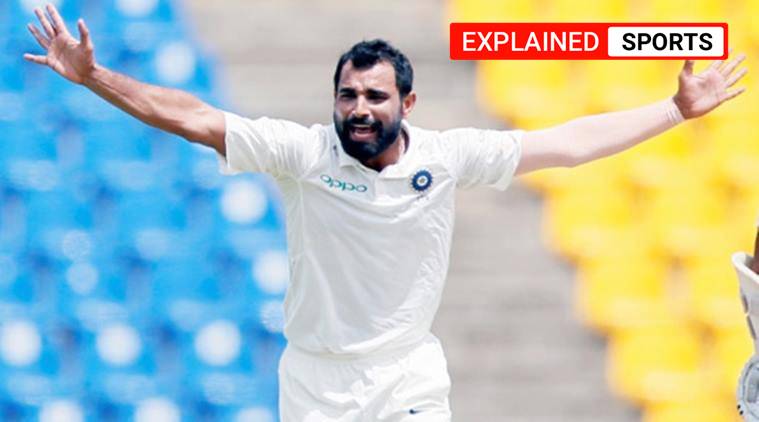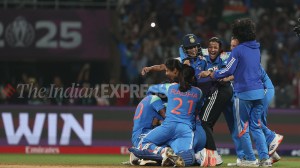What are ‘nip-backers’ and ‘heavy balls’ – and why Shami is Broad plus Gabriel
The two special deliveries have made Stuart Broad and Shannon Gabriel the game changers in the ongoing England-West Indies series. Both of these are also bowled by India's Mohammad Shami – but with a different twist.
 Shami is focussed on keeping a prominent seam and releasing the ball fluidly, without the wrist-snap. (File/Reuters)
Shami is focussed on keeping a prominent seam and releasing the ball fluidly, without the wrist-snap. (File/Reuters)
Between them, England pacers Stuart Broad and Shannon Gabriel have grabbed 15 wickets in the ongoing series with West Indies. They have troubled batsmen by seaming the ball in and varying their length.
However, they deliver the same ball differently. Broad gets the ball to skid while Gabriel’s deliveries explode off the surface.
During the course of the first two Tests of this engrossing series that is now tied 1-1, television pundits have been using some rather unusual expressions to dissect the bowling of the two fast men.
Broad, they have said, uses his “nip-backers” to get his wickets; Gabriel banks on his “heavy ball” to rattle the batsmen. Incidentally, India’s most improved pacer in recent times, Mohammad Shami, has both these arrows in his bowling quiver.
Stuart Broad’s nip-backer
As the name suggests, a nip-backer is a delivery that bends into the right handed batsman off the seam. It’s different from the clutch of other incoming deliveries — the in-swinger, for instance, moves in the air rather than off the surface (as the nip-backers does).
 Broad gets the ball to skid. (Photo: Reuters)
Broad gets the ball to skid. (Photo: Reuters)
But the nip-backer is also different from the in-cutter (or off-cutter), where the bowler cuts across the ball with his fingers, or uses a scrambled seam so that the delivery slows down after pitching and stops at the batsman.
Nip-backers work in the opposite way: after pitching, they skid sharply into the batsman, deceiving him with pace and movement. They are usually pitched in the good-length or back-of-length area, rather than full as is generally the case with in-swingers.
Shannon Gabriel’s heavy ball
The heavy ball too, is pitched roughly in the same area, although it bounces a little higher than usual, hitting the shoulder of the blade or trimming the bails.
The heavy ball doesn’t move as exaggeratedly as the nip-backer, but the extra bounce is disconcerting for batsmen. It is for this reason that batsmen are seldom adjudged leg before the wicket to a heavy ball. Played-ons are more common — Jos Buttler chopping onto the stumps in the second innings of the first Test was a classic instance.
A few deliveries earlier, Buttler had driven a delivery of similar length off Gabriel on the rise. But this time, it bounced a tad more than Buttler had anticipated. Gabriel puts more shoulder into the heavy ball — the only clue he throws up — than in other deliveries.
 Gabriel puts more shoulder into the heavy ball — the only clue he throws up — than in other deliveries. (Photo: Reuters)
Gabriel puts more shoulder into the heavy ball — the only clue he throws up — than in other deliveries. (Photo: Reuters)
In fact, most heavy-ball practitioners have massive shoulders, like Jacques Kallis, Andrew Flintoff and Michael Kasprowicz. The release point is also marginally higher.
Why batsmen dread these balls
What makes both nip-backers and heavy balls difficult is the in-between length, wherein the batsman is often caught in a dilemma whether to press forward or hang back. Attempt negotiating a nip-backer from the crease, and the batsman gets pinged in front. Try dealing with the heavy ball on the rise, and the batsman could end up dragging it onto the stumps.
Committing to the front foot prematurely is not advisable either, as the extra bounce could deceive batsmen. The movement too could be deceptive, as modern-day batsmen have a tendency to play around their front pad, making it difficult for them to cope with the late ‘nip’ back.
Shami’s nip-backer and heavy ball
India’s new-ball bowler has, over the last couple of years, used both the nip-backer and the heavy ball to trouble batsmen.
He is focussed on keeping a prominent seam and releasing the ball fluidly, without the wrist-snap. The slight inward tilt of the delivery enables the ball’s seam to land on its rough edges and cut into the batsman. The release is so good that the seam is fully upright in flight.
Shami lands both his nip-backer and heavy ball around the back-of-length area. While the nip-backer hustles off the surface, the heavy ball rears up.
The former ducks back sharply into the batsman; sometimes he gets a curve like the in-swinger. The heavy ball doesn’t move as much, but the extra bounce catches the batsman off-guard. As he pitches both on the same area of the pitch, the batsman would think it’s the nip backer.
How Shami is different from Broad
Shami’s nip-backing technique is different from Broad’s.
The latter runs his fingers down the seam, a reason his deliveries wobble, but glide off the surface. It makes the England bowler quicker than he appears, and for his height, it bounces lower than expected.
The seam, interestingly, is more inwardly tilted than Shami’s. He also grips the ball in the middle of his fingers, to enable smoother release and enhanced control. Though the ball wobbles, it lands on the seam and bends inward.
He has mastered different seam positions like very few other contemporaries – such as his leg-cutters, flicked off the middle finger, or the in-cutters delivered with a scrambled seam.
How Shami is different from Gabriel
For all the technical subtleties and uniqueness, the precision of length is fundamental to the potency of any delivery. This is where the heavy balls of Shami and Gabriel differ.
📣 Express Explained is now on Telegram. Click here to join our channel (@ieexplained) and stay updated with the latest
Shami bowls it slightly fuller than the usual back-of-length, while Gabriel bowls marginally shorter than back-of-length. Due to his beautiful wrist position – which results in a bolt upright seam – Shami can purchase more movement even with his heavy ball, whereas Gabriel works more with the angle, often flinging the heavy ball from slightly wide of the crease.
The wrist primarily does it for Shami, while it’s all shoulder for Gabriel



- 01
- 02
- 03
- 04
- 05



































